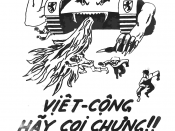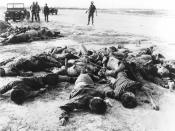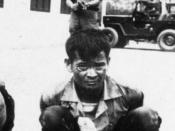When assessing the importance of the Viet Cong (VC) in the Communist victory, one cannot look past the unity, discipline and effective organisation in the vanguard of the VC forces. The Viet Cong were made up of volunteer servicemen who traveled to South Vietnam as ÃÂAutumn CadresÃÂ - ready to exploit the coming political harvest. The central purpose of the Viet Cong campaigns was to polarise the population, to divide it irrevocably from the GVN, and to mobilise it for service and sacrifice in support of the Revolution. The importance of the Viet Cong lies in their contribution to the Indochina conflict, and can be assessed through a social, political and military context.
The role of the VC in a sociopolitical context is of a significant importance in the Communist victory in the Second Indochina War. The VC forces were most numerous in rural South Vietnam, especially in Strategic Hamlet-run villages.
Once the VC established a strong presence in an area, they attempted to seal off the local population both physically and psychologically from any further contact with the Government of South Vietnam (GVN). They were particularly intent on denying the government all intelligence on Communist troop movements, bivouac sites, supply cachés, and information relating to those who serve in their local military and political infrastructures. To inhibit intelligence penetration and collection in Communist-controlled or contested areas, the VC not only systematically identified and neutralized anyone suspected of being a GVN spy or informant, but they also imposed and enforced very stringent regulations governing travel within the villages and hamlets and proscribing all unauthorized contact with GVN persons.
The indoctrination performed by the VC didnÃÂt limit the villagersÃÂ hatred to just to GVN intelligence personnel; indeed, all repressive activity was cloaked in highly emotional propaganda designed to arouse the people to a deep hatred of, a desire for revenge and to heighten their concept of revenge against the military and civilian officials serving the government. For example, in guidelines for a propaganda campaign in the Ben Tre Province for the period October 1968 to March 1969, the VC directed cadres to "make the people feel a profound hatred of the enemy's savage crimes and incite them to avenge their compatriots and kinfolk by enthusiastically and actively taking part in combat activities to heroically annihilate the enemy and achieve great merits." The indoctrination performed by the VC allowed them to gain mass support from the villagers, taking it away from the controversial GVN. This support allowed the VC to form networks across the province, which, militarily, facilitated the late offensives by the North Vietnamese Army (NVA) during the final stages of the war.
The role of the VC in a military context is of a significant importance in the Communist victory in the Second Indochina War. The Communist Field Commander for China during the Second Indochina War, Lin Piao, stated that, ÃÂIn order to win a peopleÃÂs war, it is imperative to build the broadest possible united front and formulate a series of policies which will ensure the fullest mobilisation of the basic masses as well as the unity of all the forces that can be unifiedÃÂ ÃÂ Although the VC were a persistent and ingenious force, further assessment identifies that a war of attrition was not going to win them the war. General for The NVA, General Vo Nguyen Giap, stated that, ÃÂthe way to win the war is by small defeats, one after the other until the coup de grace.ÃÂViet Cong strategy differed from other communist nations in that military activity prepared the way for a political showdown, rather than political activity preparing the way for a military showdown.
Having defined the goal of the struggle in the South as a political rather than a military victory, the Viet VC at first sought to make credible the inability of the Saigon government to administer. In response to a growing American presence, they increased their military activity in order to exploit ÃÂcontradictionsÃÂ in the American position. The VC revolutionaries took full advantage of the ÃÂcontradictionsÃÂ and tailored their military activities to exploit these perceived weaknesses by making the war so long, bloody and expensive that American opinion would turn against it. These activities intended to damage psychologically the U.S. commitment to the war, thus generating a negative cost-benefit analysis among American political leaders and thereby producing a victory more like that obtained by the Viet Minh in 1954. The essence of the VC strategy was not to defeat the U.S. and allied forces militarily but to convince the Americans through the use of violence, both persuasively and at selected points, that their position is hopeless.
This stratagem was evident in the Tet Offensive of 1968. The initial goal of Tet was to destroy the morale of the United States and GVN by proving that the communist threat did not only exist in the countryside, but in urban areas also. The VC forces attacked the US embassy in Saigon, surprising the Americans and forcing them into a conventional war. This proved costly for the Viet Cong as there were serious casualties and loss of manpower ÃÂ one third (38,000) of the VC fighting force were either killed or wounded. Due to the loss of numbers, the North Vietnamese had to infiltrate the ranks of the Viet Cong. Moreover, the VC lost local knowledge of the South Vietnamese terrain, which inhibited the abilities of the new forces from the North. Paradoxically, although the U.S. saw Tet as a military victory, the American home front did not. ÃÂTelevision effectively brought the brutality of the war into the comfort of the living room. Vietnam was lost in the living rooms of America ÃÂ not on the battlefields of VietnamÃÂ (Marshall McLuhan).
Following the Tet Offensive, support for President Johnson dropped to 26 percent, resulting in his withdrawal from the Presidential race. Nixon was elected on a promise to end AmericaÃÂs involvement in Vietnam. Politically, the Tet Offensive is considered a Communist victory. Although they lost, the military contribution of the VC during Tet effectively led to the U.S. withdrawal in 1973, allowing the NVA to initiate the North Vietnamese Offensive in 1975, causing South Vietnam to surrender unconditionally.
The role of the VC in a political context is of a considerable importance in the Communist victory in the Second Indochina War. Being influenced by mainly China and Russia, members of the VC learned the power of propaganda and in doing so became skilled at manipulating people by symbols, and in general they acquired a view of the world in which politics is the driving and dominant force. Historian Ithiel de Sola Pool states, ÃÂthe elements of the Viet Cong that will remain effective the longest after the main forces have been increasingly battered in combat will be those cadres who have built a political base in their own villages, including of course military cadres who will try to slip back into the main force.ÃÂ Further research shows that it is these cadres that are the political force in the populated areas and who can be partially won over in any politically stable settlement. They are the most politically significant and the most responsive to citizensÃÂ needs and problems. Without giving and receiving political support from the South Vietnamese population, North Vietnam was not going to win the war.
As stated before, the goal of the struggle in the South was a political rather than a military victory and this became the primary doctrine for the Communists throughout the war. The numerous guerilla incidents throughout the war had no purpose but to serve the Communist political movement. The destruction inflicted upon Vietnam by the U.S. gave the VC a political advantage in that they won the support of the South Vietnamese peasantry. The political struggle movement allowed the South Vietnamese people to contribute to the war, emphasizing that the politics within the VC are highly significant when assessing the Communist victory in the Second Indochina War.
The complex facets of the Viet Cong forces prove that they were essentially important in the Communist victory in the Second Indochina War. The Viet Cong effectively established their role in the revolution, providing support to the North as well as fighting in ÃÂforeignÃÂ territory. In contrast to such heterogeneous and disorganised elements of the GVN, the Viet Cong had at its disposal a government which dated back to 1945, a reservoir of manpower which had been unified by years of war and Communist Party discipline, and a network of agents which it had established during the war years in the cities and villages of the south. It is for these reasons that the Viet Cong were important in the Communist victory in the Second Indochina War.
BibliographyPrimary SourcesChalmers, J. The Third Generation of Guerilla Warfare, Asian Survey, Vol. 8, No. 6. (Jun., 1968), pp. 435-447.
de Sola Pool, I. Political Alternatives to the Viet Cong. Asian Survey, Vol. 7, No. 8, Vietnam: A Symposium. (Aug., 1967), pp. 555-566.
Doc. Log No. 11-1020-68 (Confidential), dated January 15, 1969, quoted in Le, Thanh Nam (1996). Control and Polarization of the Populace, 25th Aviation Battalion (online). Available at http://25thaviation.org/history/id926.htm (Accessed 21 July, 2006)Lin Piao, Long Live the PeopleÃÂs War (Peking: Foreign Languages Press, 1965), pp. 44, quoted in Chalmers, J. The Third Generation of Guerilla Warfare, Asian Survey, Vol. 8, No. 6. (Jun., 1968), pp. 435-447.





